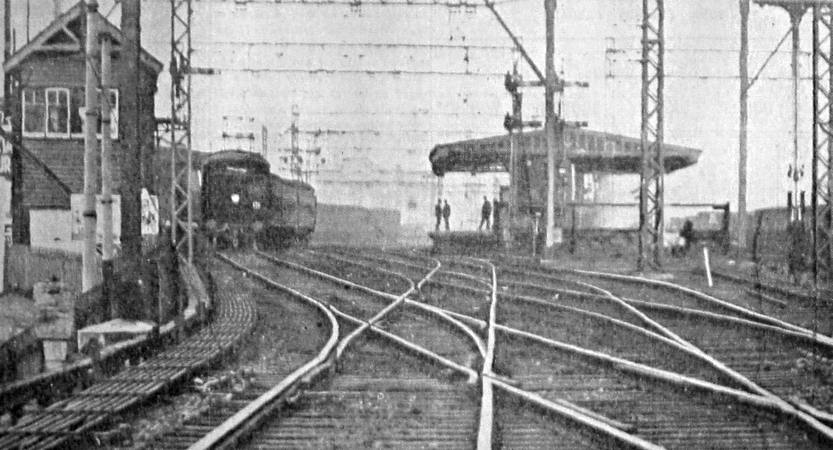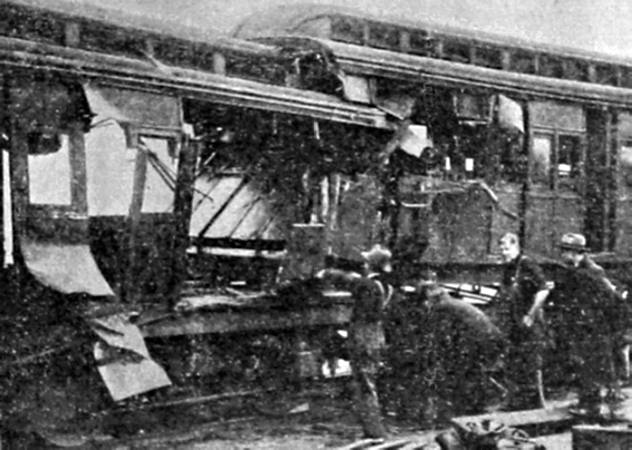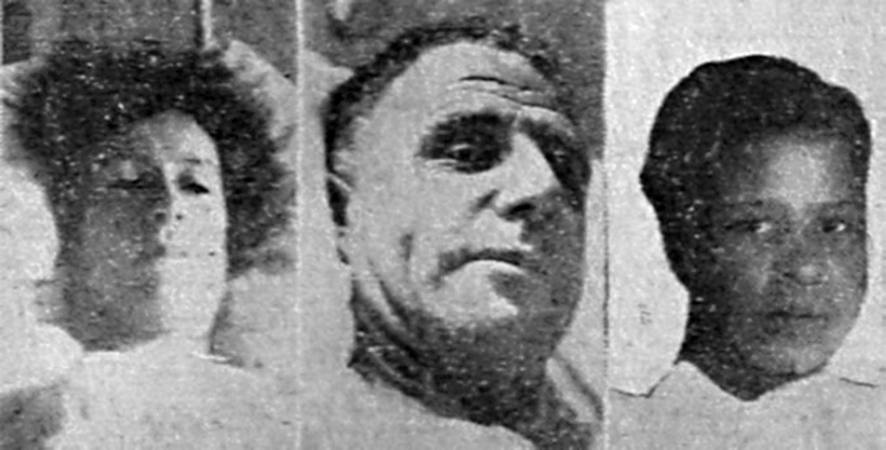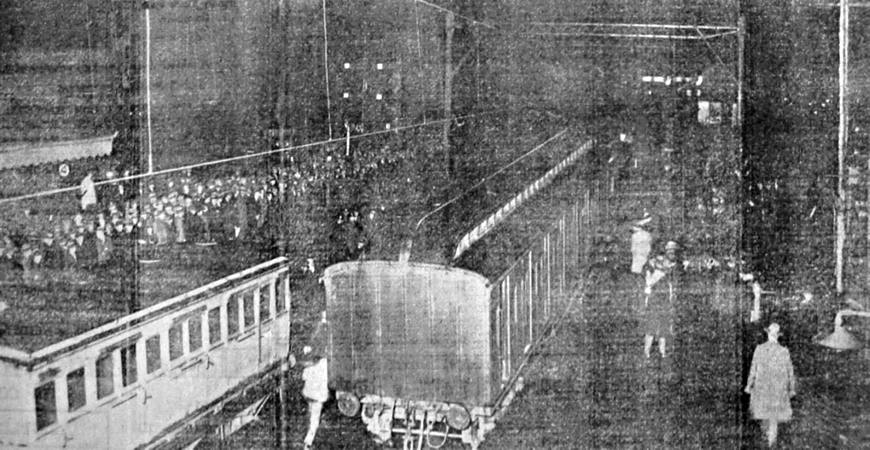Carnage and Courage at Caulfield
This story recounts the events on the night of Wednesday 26 May 1926 when tragedy struck the lives of many residents from Melbourne’s bayside communities. Beryl Clough of Catherine Avenue, Chelsea was hurrying down a wet Elizabeth Street towards Melbourne’s Flinders Street Station, with five of her friends, to catch the 5.57 Carrum train home. Like her friends she did not know of the trauma that was to develop a short time later at Caulfield.
Seventeen year old George Beames sat contently on the middle seat of the last compartment of the Carrum train. In the same compartment on the opposite seat were Martha Hudson, 56 and John Buttle, 45 sitting next to John Colville, while young Alexander McKenzie of Argyle Avenue, Chelsea sat nearby. The second class Tait car was the end carriage and a choice of convenience for Beames. It would mean a quick exit on arrival at Carrum before the walk home to the Point Nepean Road cottage where he lived with his parents, William and Edith. After a long day in the office as a clerk, the trip was something he looked forward to.
Beryl Clough and her friends managed to board the train with seconds to spare. Bella Rahally was the last passenger before the train departed on its journey, a minute late, just as darkness fell. Lillian Halfpenny, 19 sat down besides Beames next to the window opposite Colville. Halfpenny, like her friends at the cusp of adulthood enjoyed her newfound freedom. Life was bliss for all of them. Dancing, skating and going to the football were their passions. And they intended to enjoy the good times while they lasted. Halfpenny worked as a telephonist with Currie and Richards, manufactures of galvanized spouting and ironware. [1]
Hazel Sandford was the youngest of the six girls all from Chelsea, happy to just go with the flow. She sat next to Lily Willis and directly opposite to her special chum, Beryl Clough. Because the compartment was crowded, the girls had to make do the best they could. Clough herself was sitting adjacent to the passageway between compartments, besides Williams. Not that it worried them. Barely had they made themselves comfortable when the train headed towards Richmond station.
Elsewhere on the carriage of the seven vehicle train was Arthur Upton, heading back to Edithvale where he lived not far from the station with his parents. He had successfully completed his education at Mentone Boys’ Grammar School and was seen to be destined for a great future. He was justifiably proud of his recent promotion at work. And he loved his sport just as much. Captain of the local junior football club, he was instrumental in forming the first cricket team that won the ‘B’ grade premiership the year before in the Frankston-Glenhuntly Association. Life was busy for the promising twenty-one year old. In between football in winter and cricket in summer, Upton was a member of the lifesaving club and local fire brigade. His family which included five siblings were all equally proud of his achievements. [2]
When the packed train came to a halt at Caulfield station at 6.15 p.m., the ingress and egress of passengers took place. Waiting patiently for the Carrum train to depart was Stanley Weekes, 19 his destination Glenhuntly station. He was used to the train delays at Caulfield but this one was particularly long. His father’s horse Sugar King had blitzed the field winning the Aspendale Plate at Aspendale that day. [3] It would be night of celebrations on arrival at the Mernda Avenue home where he lived with his mother sister and brother. Just one more stop he thought and then home it would be.
In the second-class carriage, the last thing on Clough’s mind was superstition. But she couldn’t help remembering what her friends said yesterday morning. Just a few days before, she was knocked down by a bicycle in Flinders Street and the day after, had the misfortune of falling down a flight of stairs leading her friends to say “Well, you’ve had two accidents, the third is sure to come!” [4]
The train stood waiting at Platform 4 for an up train to arrive at Platform 3. To pass the time Ethel Williams was at her gay best telling the girls how many steps of the Charleston she could do. [5] Williams was a real character with a great sense of humour. Those extra minutes of delay enabled passengers to board the train they would otherwise have missed. Like Edward Rider, 15 who was returning home after his day’s work at the Caulfield East Post Office. Rider was one of the last passengers to board the Carrum train. His home was in Foy Avenue, Chelsea. [6]
While the Carrum train was waiting, the 6.02 p.m. Oakleigh train was approaching from Malvern, its driver unaware of the presence of the stationary Carrum train. The view of the driver of the Oakleigh train was obscured due to the idiosyncratic feature of Platform 4. He had to rely solely on a signal giving the all clear to proceed.

Caulfield Railway Station showing signal box ‘A’. A train can be seen at Platform 4. Courtesy Newspaper Collection. State Library of Victoria.
Believing it was just about to stop at Caulfield, many passengers on the Oakleigh train stood up ready to disembark. Others began to get ready to leave when the train stopped. They too had little inkling for what was about to happen until just before the impact there was a sudden grinding of the brakes and a heavy jolt as the train skidded along the track, sparks coming from the wheels. [7]
When the crash came it was as swift as it was sudden with appalling results. The last two carriages of the Carrum train were propelled forward and the two telescoped. The motorvan rose in the air more than a metre as the compartments crumbled like a concertina into a mass of mangled wreckage, shattered glass and splinted woodwork. The carriages were sent into sudden darkness as the helpless passengers tried desperately to free themselves. It was in the first three compartments of the second class carriage where the worst of the carnage occurred. Many passengers were pinned by the legs below the knees as the fronts of the seats jammed hard-up against each other.

A breakdown gang at work at Caulfield stripping one of the telescoped carriages. Courtesy Newspaper Collection, State Library of Victoria.
Tom Hiscock, 16 was reading when the crash came. Trapped and unable to move, Hiscock was wedged between the opposite seat that closed in on him. A ticket writer working at Dimmey’s Stores, Richmond, relief came when a partition was hacked down enabling Hiscock to crawl out. He was removed to the Acadia Café opposite the station and later rushed to the nearby Henty Private Hospital. [8]
On the other side of the compartment, Hazel Sandford was thrown against the end of the carriage which had crushed backwards. She fell on top of her friends and landed near Hiscock who knew the fifteen year old from Barnes Grove, Chelsea. [9] Her condition on arrival at St Benedict’s Private Hospital in Coome Crescent, Malvern was grave and many feared the worst since she suffered from very severe shock and a compound fracture of her left leg. Much to the relief of her parents Charles and Armaretta, Hazel’s condition greatly improved the following day but it was a long road ahead before time healed the emotional scars.
Beryl Clough fared better. She felt three distinct bumps before the whole carriage wall opposite crashed inwards forming a dark tent and sending Clough, Sandford and their friends sprawling on the floor piled on top of each other, legs and arms all mixed up. And like many others, Clough was pinned down to the floor by the wreckage, her legs caught and unable to move. In the darkness, the wait until assistance arrived seemed to take for hours though it could have been much worse for the sixteen year old saleswoman from Myer. [10] Her lucky escape was due to sitting adjacent to the passageway between compartments thus avoiding the full impact of the collapsed partitions. [11] She went on to make a full recovery from her leg injuries at St Leonard’s Private Hospital in Turner Street, Malvern East. Years later as Mrs Hector Skinner, she would look back and marvel at the circumstances of being third time unlucky on the “night”.

Lillian Halfpenny, Tom Hiscock and Elsie Dean. Courtesy of Newspaper Collection, State Library of Victoria.
Ethel Williams, 15 was pinned down by one leg which she managed to get free by wriggling out of her shoe, but her hope was short lived as she soon realised she was trapped and unable to exit from the crumbled compartment. Employed by Clifton Shoe Factory, Williams suffered only minor injuries to her knee and soon recovered where she joined Clough at St Leonard’s Private. Her only regret was that the accident would debar her from attending her social commitments. [12]
From his bed at St Leonard’s Private, John Buttle recounted his experience of the crash to a reporter from the Sun News-Pictorial: ‘There was a sudden crash. The lights went out. The floor of the carriage heaved upwards and broke into pieces. Girls screamed. I tried to rise, but my leg was pinned by the broken floor. All the others were jammed into their seats when the compartment crushed inwards like a concertina. It was terrible. A man sitting next to me was pinned down by part of the carriage that had fallen in. He was moaning and said he thought his back was broken. I put up my left hand to push away the woodwork, holding him down, but it was too firm. Then I heard axes biting into the woodwork, and the scene was lit by hurricane lamps. At the time of the crash the carriage was crowded, and girls were sitting on friends’ knees. Some seemed badly hurt. Some screamed, others moaned.’ [13]

Beryl Clough, John Buttle and Ethel Williams. Courtesy Newspaper Collection, State Library of Victoria.
Such was the shock of the impact, all but one of the passengers in Williams’ compartment were flung to the floor. The exception was George Beames. Jagged beams from the trailer carriage telescoped with devastating suddenness and jammed Beames between the metal and wooden uprights and flung him back to the seat. He was killed instantly. The book he was reading was still on his lap and he slouched slightly over Lillian Halfpenny as if he was still reading. [14] Halfpenny screamed in horror as he turned as white as death. Halfpenny was not the only one shaken by the shock of seeing before their eyes Beames’ tragic death. Bella Rahally, 18 suffered shock, abrasions and injuries to both legs. She worked at Ellenberg’s in Latrobe Street to help support her family as her father was an invalid. ‘I saw him crushed to death. I saw him crushed to death!’ were the words Rahally kept repeating to her mother from her hospital bed at the Alfred. [15] Rahally was still in hospital three weeks after the eventful night.
Meanwhile passengers on the Oakleigh train suffered to varying degrees. Some were violently thrown, while others felt a slight jerk. George Thomas Wright was one of those travelling in the first compartment on his way home to Springvale. The fifty nine year old left hospital the previous day after a seven week confinement for bronchitis. Just his luck he thought another stint in hospital. He was unfortunate to be on the train at all, deciding at the last minute to catch the 6.02 p.m. to Oakleigh and change at Caulfield for the Dandenong train. [16] Just another run of back luck for the five foot six inches veteran of the Great War who fought with the 40th Battalion in France.
Leonard Ashton, of 13 Ames Avenue, Murrumbeena was more fortunate. He was on the combined first and second class smoker in the middle of the train. When the impact occurred, he was jerked forward, then backwards and received a bump to the back of his head. And like many others on the Oakleigh train, he assisted with the rescue of the more unfortunate passengers. He jumped onto the track and then climbed the platform to the sight that the first and second class carriages had telescoped and heard the screams of the young helpless passengers. Soon, Ashton would be in the thick of the rescue efforts. [17]
One of the first on the scene of the accident was Alfred Richardson driving his car along Railway Street. He had just arrived outside the station when he heard the crash. Running onto the platform, Richardson soon realised the enormity of what had happened and thinking quickly he rushed to the nearby post office from where urgent telegraphs were sent to the Russell Street Police Headquarters and the Civil Ambulance Service. He also contacted the City Council and the Electric Light Company telling them that the station was practically in darkness and urged them to send out men to connect lights to assist with the rescue effort. Richardson then ran back to the station to a scene of utter confusion as a crowd formed, hampering the men cutting away wreckage to extricate the injured. While attempting to control the crowd Richardson handed his overcoat to a bystander … and never saw it again! [18]

Rescue parties at work. On the right is Platform 4. The front of the stationary train has been removed leaving only the two damaged cars. Courtesy Newspaper Collection, State Library of Victoria.
As the ambulances rushed through inner Melbourne, men were hacking away at the walls in a frantic effort to reach those trapped. Michael Pollard was prominent amongst the band of enterprising helpers. He reached the station a few minutes after it happened and without delay jumped down into the pit beneath the train and began chopping away at the walls. He soon realised that the small saws and pinch bars available on the train were hopeless and made no impression upon the framework. While some individuals dismantled doors and windows, and hacked away at the mangled wreckage, others held up hurricane lamps. [19]
It was twenty three minutes past six when Chief Officer H Osgood Cannon received the call at the Civil Ambulance depot located at 217 Lonsdale Street, Melbourne. Within two minutes, fifteen men and seven ambulances were on their way to Caulfield. [20] Cannon’s team arrived within twenty minutes to find Dr Charles Osborne preparing the wounded for transport. The men under Cannon’s command were a well drilled, professional outfit. The efficient operation they put on to remove the injured was one of the slickest things plainclothes Constable Murphy attending at the scene had ever seen. [21]
Ashton, the ambulance foreman was there to release Arthur Upton. A crowbar was used to extricate him. Though Upton’s right leg was badly crushed, he said he was alright and told Ashton to look after the others. Ashton marvelled at the young man’s bravery. [22] Dr Osborne instructed Chief Officer Cannon to take Arthur Upton, William Dobney, Stan Weekes and Frank Jude to the Alfred Hospital as the most serious cases. Dobney said he felt fine and there were others whom he thought were in a more serious condition. He said he could sit up. Others had a more urgent need of the stretchers, he claimed. Accordingly he was given a seat in the ambulance. Arriving at the Alfred Hospital Dobney insisted on walking into the casualty ward where an urgent operation was arranged. [23]
Later that night a policeman called on Mrs Colville to inform her that her foster son, William Dobney had been involved in an accident at Caulfield and had been taken to the Alfred Hospital. She was immediately taken in a police vehicle to the hospital where she arrived minutes before his death. Although the doctors had worked unceasingly in an effort to save him they were unsuccessful.
Meanwhile, Arthur Upton was attended by the resident medical officer, Dr Edward Deane. [24] Upton’s condition was so grave that twice his parents Samuel and Maria were summoned to the Alfred that night. [25] He died at 1.30 a.m. from extensive injuries to his right leg involving the knee joint, a fractured tibia, compound fracture of the foot and head injuries. Soon after her son’s death, Maria formed the Aspendale Edithvale Branch of the Alfred Auxiliary. It was her way of repaying the hospital for the kindness shown to Arthur during the final hours of his life. [26]
Stan Weekes had a fortunate escape. A fractured femur, injuries to his legs and shock were so severe that just before 11.00 a.m. the following morning, the doctors called his family to the hospital. A car was dispatched and in minimum time, his mother and siblings were at his bedside while he was unconscious. Later he regained consciousness and survived. [27] Frank Jude of Balcombe Road, Mentone like Upton was pinned down by the seats and had to be released using a crowbar. [28] He suffered a broken leg and had both thighs fractured.
Many worried family members became anxious when their loved ones failed to return. William Beames had to learn about his boy’s death the hard way. Growing increasingly anxious, he went to the local station where he first heard about the accident. The official could only say that a monthly rail ticket had been found at the scene with the name ‘BEAMES’. William rushed to Caulfield and was told of George’s death. Then it was to the morgue to identify the body. By the time the sorrowful father returned home that night it must have felt like a bad dream. [29]
The following morning many Melbournians read of the tragedy for the first time. The Argus newspaper devoted an entire page of nine columns with bold headings to the disaster. “Electric Train Accident,” “Sensation at Caulfield,” “Car Telescoped,” “Two Killed; 30 Injured” “Distressing Scene at Station.” [30]
Footnotes
- The Argus, 28 September, 1926 p13.
- Carrum Borough Gazette, 29 May, 1926 p1.
- The Herald, 27 May, 1926 p2.
- The Sun News-Pictorial, 27 May 1926, p10.
- The Herald, 27 May 1926.
- The Sun News-Pictorial, 27 May 1926, p10.
- The Argus, 23 Jun 1926, p19.
- The Sun News-Pictorial, 27 May 1926, p10.
- The Sun News-Pictorial, 27 May 1926, p10.
- The Argus, 27 May 1926, p11.
- The Age, 27 May 1926, p9-10.
- The Herald, 27 May 1926, p1.
- The Sun News-Pictorial, 27 May 1926, p10.
- The Herald, 26 May 1926, p1.
- The Herald, 27 May 1927, p7.
- The Age, 27 May 1926, p9.
- VPRS 30/P/O Unit 2143 File 464. © State of Victoria. Reproduced with the permission of the Keeper of Public Records, Public Record Office Victoria, Australia.
- The Herald, 26 May 1926, p1.
- The Sun News-Pictorial, 27 May 1926, p3.
- The Argus, 27 May 1926, p11.
- The Sun News-Pictorial, 27 May 1926, p10.
- The Age, 28 May 1926, p9.
- The Age, 28 May 1926, p9.
- VPRS 30/P/O Unit 2143 File 464. © State of Victoria. Reproduced with the permission of the Keeper of Public Records, Public Record Office Victoria, Australia.
- The Herald, 27 May 1926, p1.
- “Mr and Mrs Sam Upton” held by Chelsea and District Historical Society Inc.
- The Herald, 27 May 1926, p1.
- The Age, 28 May 1926, p9.
- The Herald, 27 May 1927, p7.
- The Argus, 27 May 1926, p11.
